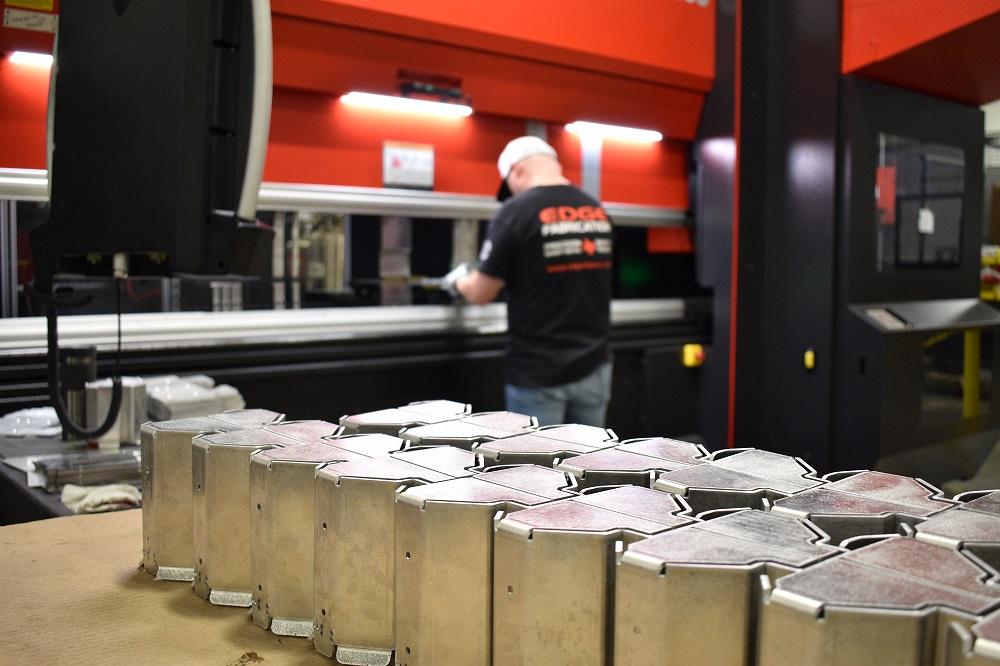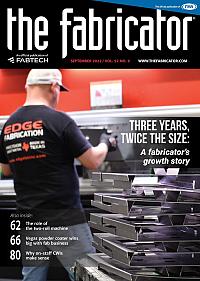Senior Editor
- FMA
- The Fabricator
- FABTECH
- Canadian Metalworking
Categories
- Additive Manufacturing
- Aluminum Welding
- Arc Welding
- Assembly and Joining
- Automation and Robotics
- Bending and Forming
- Consumables
- Cutting and Weld Prep
- Electric Vehicles
- En Español
- Finishing
- Hydroforming
- Laser Cutting
- Laser Welding
- Machining
- Manufacturing Software
- Materials Handling
- Metals/Materials
- Oxyfuel Cutting
- Plasma Cutting
- Power Tools
- Punching and Other Holemaking
- Roll Forming
- Safety
- Sawing
- Shearing
- Shop Management
- Testing and Measuring
- Tube and Pipe Fabrication
- Tube and Pipe Production
- Waterjet Cutting
Industry Directory
Webcasts
Podcasts
FAB 40
Advertise
Subscribe
Account Login
Search
How a custom metal fabricator doubled revenue amid the pandemic
Dallas-based Edge Fabrication grew with good technology, good data, and good people
- By Tim Heston
- September 9, 2022
- Article
- Shop Management
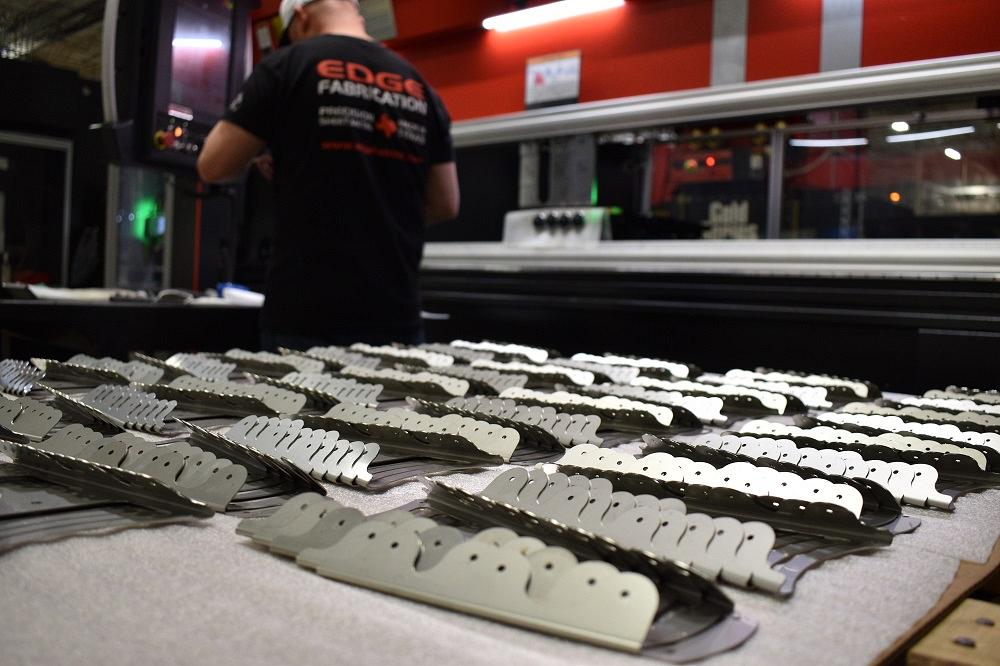
An experienced operator forms a cosmetically critical part using a setup involving complex gauging and urethane tape to avoid marking.
“The sheet metal business requires automation and smart people. You need both.”
So said David Cohen, general manager at Edge Fabrication, a Dallas-based custom metal fabricator that—through a pandemic, supply chain challenges, roller coaster material prices, and a labor shortage—has doubled in size since 2019. As of this writing, growth hasn’t slowed. According to Cohen, the shop, which specializes in 7-ga. and thinner materials, has benefited from increased infrastructure investment and reshoring.
The operation hasn’t been timid about reinvestment either. The company has two AMADA ATC (automatic tool change) press brakes, one of which with sheet followers; and a new AMADA punch/laser combo with a tower and part removal, as well as a tool changer that holds more than 200 punch tools.
All this said, Cohen doesn’t look at any of this in isolation. As Edge’s general manager, he joined his family’s business 10 years ago, bringing a fresh perspective with him: specifically, a background in data analytics. At its essence, custom metal fabrication is a study in time. Each job routing, from quoting and order entry to shipping, has a web of data points that affect how quickly the work flows. Cycle times in bending and cutting matter, but so does the timely arrival of materials and purchased components, not to mention the reliability of outside service providers. Making best use of all these data points, plus a healthy dose of common sense, has helped Edge ride a wave of demand that never abated, even through the worst of the pandemic.
Sheet Metal Fab Is Easy, Right?
In 2011, Cohen’s family launched Thermal Edge, a maker of industrial-enclosure climate control systems. Two years later, they purchased the assets of another Dallas area sheet metal job shop and launched Edge Fabrication, operating it as Thermal Edge’s sheet metal fabrication division. Today, Edge Fabrication's custom fab work represents the lion’s share of its business; Thermal Edge is just one of many customers. That said, the custom business didn't grow into what it is today overnight.
Cohen chuckled. “It’s sheet metal. How hard could it be? Well, as it turned out, quite hard.”
Such a rude awakening isn’t unusual when product manufacturers bring sheet metal in-house. Sure, a sheet metal part looks simple enough, but building an effective fabrication operation can get immensely complex, especially when multilevel bills of material get involved—when, say, an enclosure needs to be assembled with a purchased component at just the right time, and it all must bee juggled with hundreds of different jobs on the floor.
Good use of data and systems has given Edge Fabrication, well, an edge. There’s no magic to it. Much of it boils down to traceability, knowing exactly what happened where to which part, and knowing where the material came from. The rest involves scrutinizing every process, from quoting to shipping.
A Nice Place to Work
Cohen emphasized, however, that besides data, a healthy dose of common sense plays a role too. He pointed to the breakroom’s espresso machine that grinds fresh beans. He then pointed out to the well-lit, clean shop floor. And he pointed out the temperature: a comfortable 74 degrees, even during a summer heat wave in Texas. Data analytics helped when streamlining operations, but to make the workday better for employees, the managers just made some common-sense decisions.
“From a cleanliness perspective, we knew two things had to happen when we moved in here [in early 2019],” Cohen said. First, the air had to be clean. You won’t find blue haze hovering over the shop. Fumes are collected, deburring and grinding occur in booths—good for quality and safety, considering the range of materials the shop processes. About 40% of the material flowing through the operation is some grade of stainless steel; the remainder is some mix of carbon steel and aluminum.

Dallas-based Edge Fabrication doubled revenue between 2019 and 2022 during a pandemic, supply chain challenges, and an acute labor shortage.
“Second, we knew we needed full climate control,” Cohen said. “We have two air-rotation units, the kind that are used in aircraft hangers, and we have giant filters on them. Just two air conditioners for the whole facility keep us at a lovely 74 degrees all year round.”
Cohen described all this as one building block that helps Edge attract and retain talent. “You have to have good benefits and you have to have fair pay. You need safe, high-quality working conditions. And you need to give people access to good training and opportunity.”
Edge isn’t immune to the industry’s labor shortage. The shop still struggles to find good people. It’s just that when people join, they tend to stay. “We don’t typically lose people,” Cohen said. “I don’t think we lose more than a few people a year, if that.”
He added it also takes more than air conditioning and a clean shop to attract and retain good people. As a prime example, he pointed to an AMADA ATC brake with sheet followers and a bend indicator for in-process angle measurement. “They’re not having to lift tooling, and they’re not breaking their backs.”
The bend indicator ensures a first-part, good-part setup, while the sheet follower makes operators’ jobs easier and safer and ensures quality by taking variability of manual operation out of the equation. Especially when bending flanges on large sheets, gravity has an effect as the sheet swings upward; a sheet follower helps remove that variability.
For Cohen, automation in custom fab isn’t really about speed. Anyone can buy a high-powered laser and marvel at the cutting and rapid-traverse speeds. But what about the programming, microtabbing, and making life easier for the team? What about inspecting part edges and deciding which pieces need to go through the flat-part deburring system? What about ensuring bend programs just run correctly the first time?
As Cohen described, Edge’s strategy is to use automation to complement and augment shop floor talent. To illustrate the concept, he described the shop’s use of offline bend programming. Two of Edge’s most experienced brake operators (who have more than 50 years of bending experience between them) now program the brakes offline. The effort has helped standardize setups across the shop and, most important, has helped automate the most mundane, irritating portions of a brake operator’s job: dealing with work not designed around available tooling. Jobs sent through offline bend simulation use die widths suited for the work. And for the ATCs in particular, the tools are already there, either on the brake bed or on adjacent mechanized racks, ready to be moved in place.
All this allows the shop’s brake gurus to focus on the most challenging jobs. “Software’s great, but for the really complex work, the human intervenes,” Cohen said. “That’s where our guys with 20 to 30 years of experience come in and find a better way.” These might involve parts with intricate bend sequences that, if not performed just right, could introduce some tooling collisions. For other parts, an operator might form a flange partially, then move to another flange before completing the rest of the first bend. As Cohen put it, “It’s the kind of thing where, if you didn’t spend serious time in front of a brake, you just wouldn’t see it.”
The Silent Brainstorm
Rework is another annoyance that makes the job less than stellar. It might be something as simple as misplaced hardware. Perhaps the wrong part revision made it to the floor, or a customer miscommunication is to blame. Broadly speaking, rework is just one of numerous unexpected variabilities that can rear their ugly heads throughout the business. Dealing with too many of them can be a custom fab shop’s Achilles’ heel.
To identify and mitigate such variability, Cohen and his team didn’t just turn to high-tech measurement systems or rely on complex analytics. Instead, he called a meeting and brought a pile of Post-It notes.
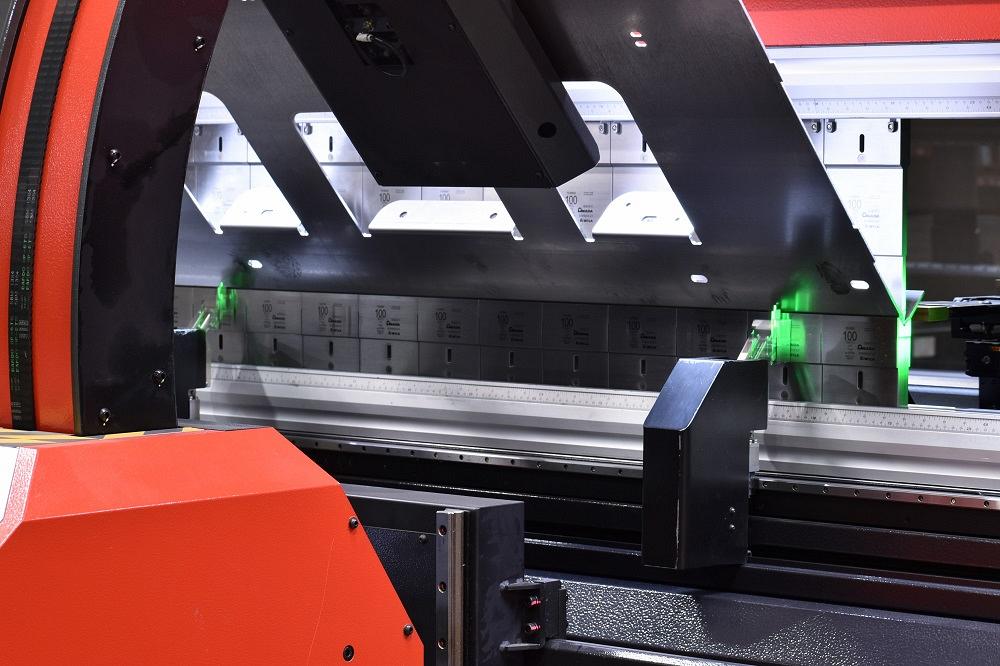
A sheet follower helps an operator form an edge flange on a complicated part, using one of the company’s two ATC press brakes. Bend indicators use probes to measure the angle in-process.
“We brought 15 people in from across the business,” Cohen said. The team created a process map, detailing the duties of each business function and how an order flowed through the business, from quote to ship. “Then we did one of my favorite activities—the silent brainstorm. For 20 minutes, we sat silently and wrote out our ideas, one idea per Post-It Note. We then grouped those notes by functional area.” Quoting, engineering, purchasing, order entry, scheduling, quality, cutting, bending, welding, finishing, assembly—each group had ideas to make their jobs easier. “From that, we built a plan to encompass those ideas, creating a platform that works for us.”
The Importance of Data
This and similar meetings took place about four years ago. His goal was to ramp up Edge Fabrication, transforming it from a division that served Thermal Edge into a stand-alone enterprise. Cohen and his team knew Dallas was a growing area, and they wanted to tap into it. “Talented people are moving here,” Cohen said, “and they’re coming here to work.”
Cohen also knew they needed to invest in automation, and not just of the “hard” variety either. Automatic tool change in bending and part-picking in blanking are great technologies, but they won’t grow a business with inefficient processes elsewhere. This includes office functions like quoting and purchasing. This drove Cohen to upgrade Edge’s enterprise resource planning (ERP) system, choosing Infor’s Visual platform. During all this, those silent brainstorms full of Post-It notes played a critical role.
“So many times, we saw Post-Its with identical process steps,” Cohen recalled, explaining that two people in different areas of the company basically performed the same thing. “And the best was when we saw process steps that wouldn’t even apply under the new system.” This included customized software for the purchasing function. “Pre-pandemic, we went to two to three vendors to quote sheet metal. Now the pandemic hits, and some vendors don’t even have materials, and others have outrageous prices. So, we built an automated RFQ system that emails three times the number of vendors. They fill out a form, send it back, and our system loads it all into a dashboard for the purchasing manager. So, the whole mess of sifting through random emails [sent from various suppliers] just went away.” The dashboard organizes the quotes by price and lead time, incorporating factors related to vendor performance.
The transformation in purchasing was just one part of a detailed analysis of every process step in Edge’s business. At the business’s core is traceability—the ability to track down what exactly happened to what part or material, where and when, then to use that data to make decisions about the next job or the next machine or software investment.
“The big one for us is lot traceability for our sheets,” Cohen explained. “So, we issue a specific lot of material for a specific job. If we ever have an issue, we can go back and ask, ‘Who issued it? What vendor did it come from? What day did it arrive?’”
Good data helps with job scheduling too. Upon order release, the shop might have everything it needs to start a job except for, say, one purchased component—but there’s no panic. The order for that component was placed several weeks before, and the job release to the floor was carefully timed to coincide with the purchased component’s arrival. The order processes through the shop, and that one missing component arrives at just the right time.
When the order was initially processed, the purchaser knew that it would take several weeks for that purchase component to arrive. He also has historical data showing how long the vendor took previously, as well as that vendor’s delivery reliability.
As Cohen explained, Edge isn’t immune to supply chain mishaps. But having good data minimizes their impact on production. Edge doesn’t want to release an order and then scramble for missing material, nor does it want to delay order release until everything is in-house; overall lead-time would be too long. Instead, it wants purchasing to move in sync with the rest of the operation, ordering special material or purchased components at just the right time.
Ingredients for Growth
Walk Edge Fabrication’s shop floor and it becomes easier to understand just how this 50-employee shop grew so quickly over the past few tumultuous years. It’s the little things.
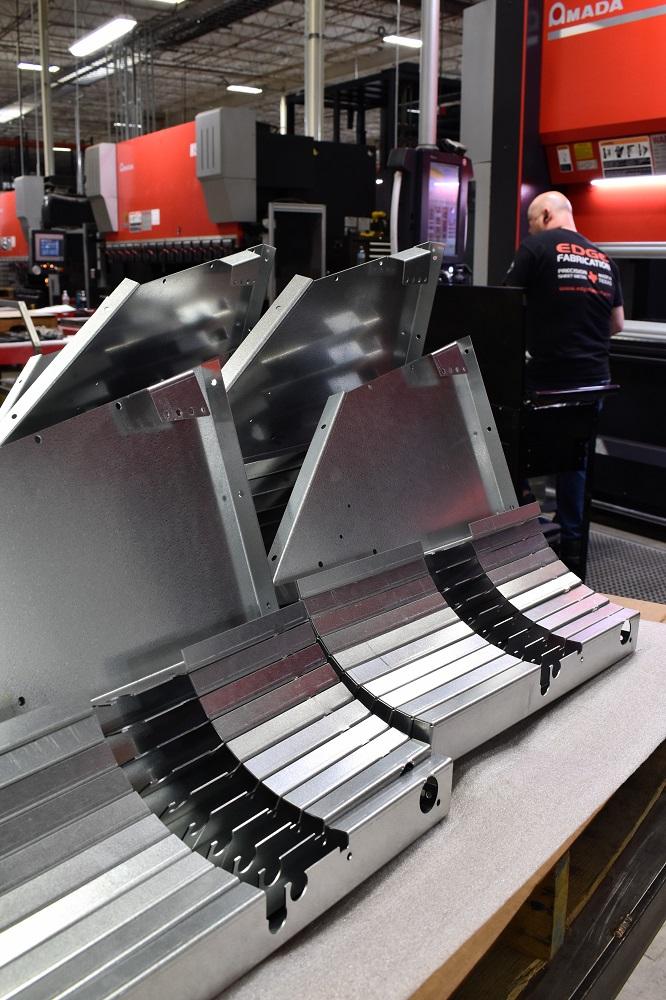
Edge’s brake department employs a mix of operators, from those just learning the ropes on the ATC brakes to experienced personnel who program offline and work through some of the company’s most challenging parts.
In hardware, you’ll see operators scan QR codes in bins of fasteners, ensuring the nut being inserted matches the one on the print. Walk past the punch/laser combo to the punch tool storage area and you’ll see a seemingly mundane activity: punch regrinding. Nothing unusual there, except that the once tedious task of punch tool management is now basically automated. Every one of Edge’s 220 punch tools in the magazine has a QR code that tracks its exact usage. Manual inspection is still required, of course, to account for unexpected tool wear. But the tool-management automation provides a big assist, building a database of tool usage and wear trends.
Then walk to bending and you’ll witness just how profoundly automatic tool change has altered the press brake world. Cohen shook his head and smiled. “We used to do two or three setups a day, with each setup taking between 30 and 45 minutes. Now, we’ve cut each setup down to just a few minutes each.”
A brake operation now undergoes literally dozens of setups over a shift, allowing small batches of parts to flow quickly to assembly. Cohen pointed to a supervisor working with an operator on a complicated, 11-bend demo part for a customer.
“We never used to do that,” he said, explaining that breaking into production for a complicated prototype just didn’t make economic sense. With automatic tool changes, the story has changed.
“When we have a prospective customer come in, and they have a complicated part, with these machines, we can set up that job in about three minutes,” Cohen said, explaining that the setup has already been developed and simulated offline. “We bend the part and then, five minutes later, the operator goes back to the previous job they were working on. It’s allowed us to be so flexible.”
Bending remains the heartbeat of many precision sheet metal operations, and Edge is no exception. Large workpieces emerge from the company’s open-bed CO2 laser. Intricate pieces with punched forms emerge from the punch/laser combo with a tower and part-picking automation. Pieces with contoured edges emerge from the fiber laser with automated loading/unloading. One job might require parts from all three blanking centers.
“Imagine batches of five different, complicated parts arriving at the brake,” Cohen said. “Traditionally, it would have taken someone at a regular press brake all day to process those parts. Now [with automatic tool changes], we can have the entire job finished in two hours. In certain cases, we can increase throughput by up to 75%, especially when we have rails of tools that span across the 14-ft. bed. It would have taken an operator up to 40 minutes just to load those tools by hand. Now, the tools change out in 90 seconds, and we’re up and running a few minutes later.”
Workers on the ATC still turn to the shop’s bending gurus. Some gurus spend most of their days programming, while others train operators and dedicate a portion of their day to running challenging jobs. The automation hasn’t pushed knowledge off the shop floor; it’s just changed how new operators learn the process.
Perhaps most important, everyone in the shop is supported by good information. Customers still request rush orders, but with automation in blanking and bending, managers needn’t move heaven and earth to shove them through the shop. Operators just see them as the next order on the docket.
Still, data on its own does not a sustainable business make. Cohen pointed to the company’s welding department. Edge has a robot that performs gas metal arc welding, but nearly everyone in the manual booths is adept at wielding a gas tungsten arc welding torch, often achieving a pristine, stack-of-dimes look. “How have we grown, really? Good people, good people, and good people.”
About the Author

Tim Heston
2135 Point Blvd
Elgin, IL 60123
815-381-1314
Tim Heston, The Fabricator's senior editor, has covered the metal fabrication industry since 1998, starting his career at the American Welding Society's Welding Journal. Since then he has covered the full range of metal fabrication processes, from stamping, bending, and cutting to grinding and polishing. He joined The Fabricator's staff in October 2007.
Related Companies
subscribe now

The Fabricator is North America's leading magazine for the metal forming and fabricating industry. The magazine delivers the news, technical articles, and case histories that enable fabricators to do their jobs more efficiently. The Fabricator has served the industry since 1970.
start your free subscription- Stay connected from anywhere

Easily access valuable industry resources now with full access to the digital edition of The Fabricator.

Easily access valuable industry resources now with full access to the digital edition of The Welder.

Easily access valuable industry resources now with full access to the digital edition of The Tube and Pipe Journal.
- Podcasting
- Podcast:
- The Fabricator Podcast
- Published:
- 04/16/2024
- Running Time:
- 63:29
In this episode of The Fabricator Podcast, Caleb Chamberlain, co-founder and CEO of OSH Cut, discusses his company’s...
- Trending Articles
Tips for creating sheet metal tubes with perforations

Are two heads better than one in fiber laser cutting?

Supporting the metal fabricating industry through FMA

JM Steel triples capacity for solar energy projects at Pennsylvania facility

Omco Solar opens second Alabama manufacturing facility

- Industry Events
16th Annual Safety Conference
- April 30 - May 1, 2024
- Elgin,
Pipe and Tube Conference
- May 21 - 22, 2024
- Omaha, NE
World-Class Roll Forming Workshop
- June 5 - 6, 2024
- Louisville, KY
Advanced Laser Application Workshop
- June 25 - 27, 2024
- Novi, MI
























